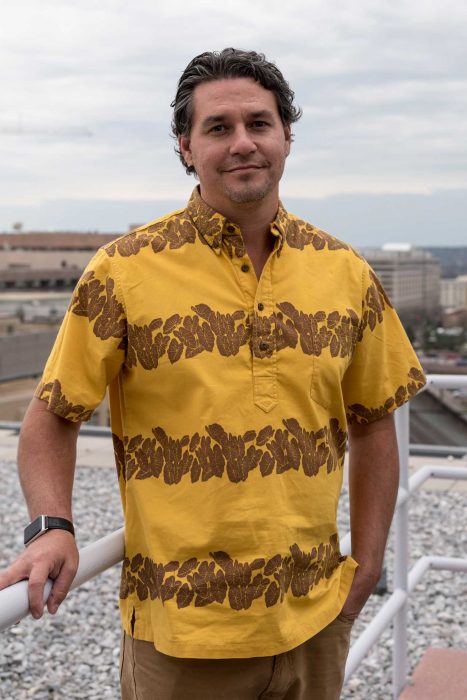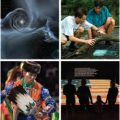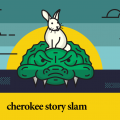A few of my favorite things: Kālewa Correa
Smithsonian staff and volunteers work countless hours in the halls of our museums and research centers, in the field, at the Zoo, in our gardens and facilities. We are privileged to spend time with some of the nation’s most cherished treasures as we go about our duties. Sometimes, these unique experiences find a special place in our own personal stories. Amy Kehs introduces Kālewa Correa, and a few of his favorite things
The Smithsonian Asian Pacific America Center (APAC) is one of the Smithsonian’s “museum without walls.” Founded in 1997, it may be the youngest of the Smithsonian Centers but that hasn’t stopped it from tackling important projects. I recently had a chance to talk to Kālewa Correa, APAC’s Curator of Hawai’i and Pacific America. Kālewa, a full time resident of Hawai’i, loves his job finding, preserving and sharing the stories and history of Hawai’i and the other Pacific American islands.

Kalewa Correa is the Smithsonian’s curator of Hawaiʻi and Pacific America.
Photo credit: Smithsonian
While working to fulfill a college language requirement, Kālewa took a class on the Hawaiian language and fell in love with not only his native language but also the door that it opened to the history and culture of Hawai’i of which he was unaware. He immediately dropped his degree in audio engineering and started working to become proficient in Hawaiian history and culture. His degree led him to his first curator position at Imiloa, a museum in Hilo (home of the Mauna Kea Observatories and other astronomical research facilities), that brings members of the Hawaiian and scientific communities together. That position, along with other jobs throughout the Pacific, led him to the Smithsonian. He is very proud of the work the small but mighty APAC team does. With just nine fulltime employees, APAC is the smallest Smithsonian unit but the passion and energy of the staff create a much bigger impact. A “museum without walls” is the perfect spot for Kālewa as he’s been able to use his love of digital media to highlight his expertise in Hawaiian culture. I wasn’t surprised that all three of Kālewa’s favorites are APAC-inspired.
The first thing on Kālewa’s list of Smithsonian favorites is the Center’s “Culture Labs” program. Culture Labs are curated programs that bring artists, scholars and the public together to discuss important topics in creative ways. The staff at APAC hopes that this flagship program inspires other museums around the globe to use a similar model to start important conversations that lead to preserving culture. The first three APAC Culture Labs were held in Washington, D.C., New York City and Honolulu. The fourth one is currently in the planning stages and will be the first international Culture Lab. The Center carefully selects the participants, including artists, musicians, scholars, curators and community members. Together, they create a forum where everyone can discuss and collaborate in a respectful and safe space. Visitors to an APAC Culture Lab will have a highly interactive experience that is colorful, musical, poetic and probably emotional. Each Culture Lab promises to be unique and inspirational, but centered on building community by using and sharing art, history, science and stories.
‘Ae Kai: A Culture Lab on Convergence
“The time spent together at a Culture Lab often leads to communication and understanding. Those bonds can blossom into lifelong collaboration and important partnerships within communities,” says Kālewa.
Kālewa’s second favorite is APAC’s “Our Stories Digital Storytelling Initiative.” This labor of love is a win-win for everyone. Launching this spring, the program will teach Hawaiian high school students digital media and storytelling skills. They then will go out into their communities to find the history and stories of their elders and using digital media, document and preserve these oral histories. Not only will the initiative preserve community history, it helps students develop creative and critically important digital skills.
“There is a lot of commercial filming that takes place in Hawai’i. But then, the creative process is done somewhere else. We want to give these students the skill set so a new generation is creating content here in Hawai’i. We hope to inspire some young, passionate storytellers and help start a niche in the industry in their homeland,” says Kālewa, “The bonus is that while they are learning this craft they are also learning the history of their heritage and preserving it.”
Kālewa’s third Smithsonian favorite is the oldest documented existing Hawaiian canoe in the world. When Queen Kapiolani sent this canoe to the Smithsonian in 1887, it was thought to already be 100 years old. Now Kālewa is working with his Smithsonian colleagues to restore and study this important artifact so it can be used to teach the craft of canoe making to young people. The Torch will be following this collaborative effort and will be telling you more as the project develops.
Kālewa’s passion for the history and culture of Hawaiians and Pacific Islanders is visible through his work at APAC and its efforts to preserve the often exploited and forgotten culture of the region. Stay tuned for more exciting programs from APAC in 2019.
Uncovering the Secrets of Queen Kapi’olani’s Canoe
Posted: 15 March 2019
- Categories:







